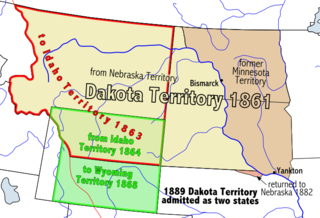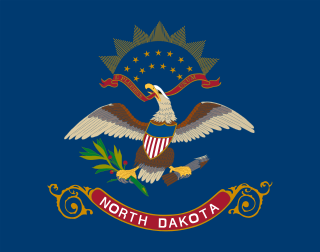
The governor of South Dakota is the head of government of South Dakota. The governor is elected to a four-year term in even years when there is no presidential election. The current governor is Kristi Noem, a member of the Republican Party who took office on January 5, 2019.

The Territory of Dakota was an organized incorporated territory of the United States that existed from March 2, 1861, until November 2, 1889, when the final extent of the reduced territory was split and admitted to the Union as the states of North and South Dakota.
The 100 seats in the United States Senate are divided into three classes for the purpose of determining which seats will be up for election in any two-year cycle, with only one class being up for election at a time. With senators being elected to fixed terms of six years, the classes allow about a third of the seats to be up for election in any presidential or midterm election year instead of having all 100 be up for election at the same time every six years. The seats are also divided in such a way that any given state's two senators are in different classes so that each seat's term ends in different years. Class 1 and class 2 consist of 33 seats each, while class 3 consists of 34 seats. Elections for class 1 seats are scheduled to take place in 2024, class 2 in 2026, and the elections for class 3 seats in 2028.

The Oregon Constitution is the governing document of the U.S. state of Oregon, originally enacted in 1857. As amended the current state constitution contains eighteen sections, beginning with a bill of rights. This contains most of the rights and privileges protected by the United States Bill of Rights and the main text of the United States Constitution. The remainder of the Oregon Constitution outlines the divisions of power within the state government, lists the times of elections, and defines the state boundaries and the capital as Salem.

The Territory of Idaho was an organized incorporated territory of the United States that existed from March 3, 1863, until July 3, 1890, when the final extent of the territory was admitted to the Union as Idaho.

The North Dakota Legislative Assembly is the state legislature of the U.S. state of North Dakota. The Legislative Assembly consists of two chambers, the lower North Dakota House of Representatives, with 94 representatives, and the upper North Dakota Senate, with 47 senators. The state is divided into 47 constituent districts, with two representatives and one senator elected from each district. Due to the Legislative Assembly being a biennial legislature, with the House and Senate sitting for only 80 days in odd-numbered years, a Legislative Council oversees legislative affairs in the interim periods, doing longer-term studies of issues, and drafting legislation for consideration of both houses during the next session.

The Great Seal of the State of Georgia is a device that has historically been used to authenticate government documents executed by the state of Georgia. The first great seal of the state was specified in the State Constitution of 1777, and its current form was adopted in 1799 with alterations in 1914. Its specifications are currently spelled out by statute.

The Washington State Legislature is the state legislature of the U.S. state of Washington. It is a bicameral body, composed of the lower Washington House of Representatives, composed of 98 Representatives, and the upper Washington State Senate, with 49 Senators plus the Lieutenant Governor acting as president. The state is divided into 49 legislative districts, each of which elect one senator and two representatives.

The seal of Indiana is used by the governor of Indiana to certify official documents of the U.S. state of Indiana. The seal has gone through several revisions since the region was a part of the Northwest Territory. It is likely that the original seal, which is similar to the current one, was created by William Henry Harrison during his administration of the Indiana Territory. The current design of the seal was standardized by the Indiana General Assembly in 1963.

The Constitution of the State of New Jersey is the basic governing document of the State of New Jersey. In addition to three British Royal Charters issued for East Jersey, West Jersey and united New Jersey while they were still colonies, the state has been governed by three constitutions. The first was adopted on July 2, 1776, shortly before New Jersey ratified the United States Declaration of Independence and the second came into effect in 1844. The current document was adopted in 1947 and has been amended several times.

The Great Seal of the State of Ohio is the official insignia of the U.S. state of Ohio. All governmental offices, agencies, and courts in Ohio use variations of the state seal. Its primary feature is a circular coat of arms that depicts a sunrise in Chillicothe, Ohio's first capital, along with symbols of the state's origins. The seal sometimes appears with the state motto, "With God, All Things Are Possible".

The Great Seal of the State of South Dakota was designed while the area was a territory, in 1885. The outer ring of the seal contains the text "State of South Dakota" on the top and "Great Seal" on the bottom. Also, the year of statehood was 1889. Inside the inner circle of the seal contains the state motto "Under God the People Rule". The picture features hills, a river with a boat, a farmer, a mine, and cattle. The items in the image are to represent the state's commerce, agriculture, industry, and natural resources.

The State Seal of the Republic of the Union of Myanmar is the national emblem used in all official government documents, including publications. As the seal is an official symbol, there are State Seal Law and Principles regarding appropriate usage of it.

The Constitution of the State of West Virginia is the supreme law of the U.S. state of West Virginia. It expresses the rights of the state's citizens and provides the framework for the organization of law and government. West Virginia is governed under its second and current constitution, which dates from 1872. The document includes fourteen articles and several amendments.

The following outline is provided as an overview of and topical guide to the U.S. state of North Dakota:

The Great Seal of the State of Minnesota is the state seal of the U.S. state of Minnesota. Originally adopted in 1858 following Minnesota's statehood, the seal's original version is an adaptation of Minnesota's territorial seal modified by the state's first governor and fur trader, Henry Hastings Sibley. It has been modified several times by the state legislature since 1858, including in 1971 and 1983. The seal's design symbolizes many important aspects to Minnesota's history and culture; such as the growth of industry powered by Saint Anthony Falls, the state's Native American heritage, the importance of industries like lumber and agriculture, and the taming of the wilderness by the state's early pioneers. The seal is prominently featured on the Minnesotan flag.

Historical coats of arms of the U.S. states date back to the admission of the first states to the Union. Despite the widely accepted practice of determining early statehood from the date of ratification of the United States Constitution, many of the original colonies referred to themselves as states shortly after the Declaration of Independence was signed on 4 July 1776. Committees of political leaders and intellectuals were established by state legislatures to research and propose a seal and coat of arms. Many of these members were signers of the Articles of Confederation, Declaration of Independence, and United States Constitution. Several of the earliest adopted state coats of arms and seals were similar or identical to their colonial counterparts.


















